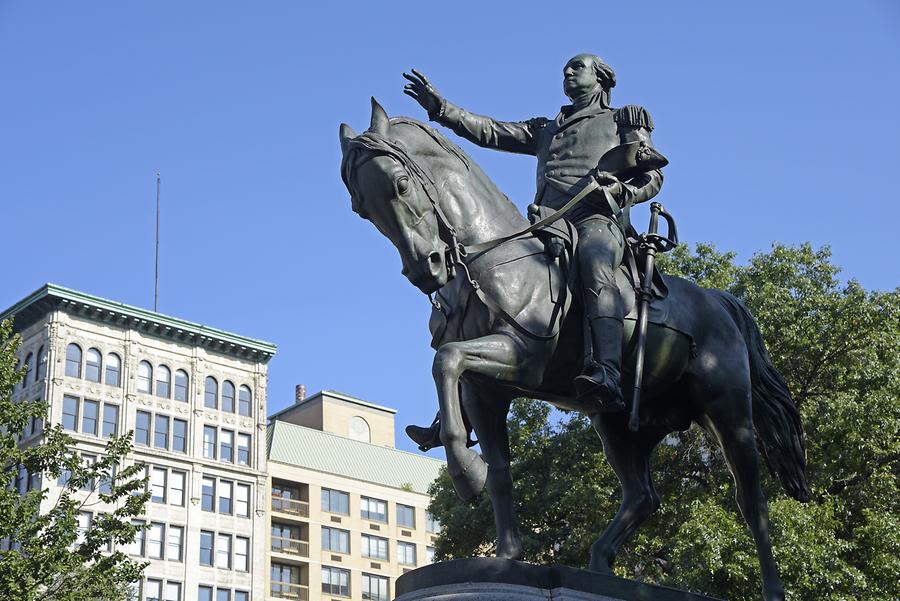Union Square - Statue of George Washington#

Union Square - Statue of George Washington, August 2017, © Gerhard Huber, under CC BY-NC 4.0 +Edu
Einen Rundgang durch die Villages beginnt man am besten am Union Square
Union Square, New York
, bis heute liebster Versammlungsplatz der New Yorker. Darüber wacht ein Reiterstandbild. Wenn man nicht weiß, um wen es sich handelt, tippt man am besten auf George Washington. Damit liegt man meistens richtig, so auch in diesem Fall.
Für New Yorker Taxifahrer sind die Villages ein Alptraum, für alle anderen ein kleines Paradies: Zwischen den hektischen Wolkenkratzervierteln von Midtown und Lower Manhattan fühlt man sich unvermutet in eine dörfliche Atmosphäre versetzt. Kleinstädtische Enklaven wie Chelsea, West Village, Greenwich Village und Soho lassen vergessen, dass man sich inmitten einer Weltmetropole befindet, die ansonsten mit ihrem Gigantismus den Besucher fast erschlägt. Taxifahrer verzweifeln hier, weil die Straßen keine fortlaufenden Nummern, sondern Namen tragen. Sie kreuzen sich nicht im rechten Winkel, sondern verlaufen und krümmen sich so, wie sie gewachsen sind. Die Gegend bestand ursprünglich aus Dörfern, bevor die Stadtväter 1811 ihr Rastermuster über Manhattan zogen. Hierher fuhren die New Yorker schon im 18. Jahrhundert zur Sommerfrische.
Als die großen Einwanderungswellen einsetzten, fanden zahlreiche Immigrantenfamilien in den Villages billige Unterkünfte. Sie prägten die Stadtviertel mit ihrer jeweiligen Kultur, doch die Armut ließ viele Dörfer zu Slums verkommen. Was dann Anfang des 20. Jahrhunderts passierte, nennt man Gentrifikation: Künstler entdeckten die heruntergekommenen Viertel und richteten hier ihre Werkstätten ein. Galeristen, Restaurantbesitzer und Immobilienmakler folgten. Die ehemaligen Slums wurden zum bevorzugten Wohngebiet und die Preise für Grund und Mieten stiegen in astronomische Höhen.
A tour of the Villages is best started at Union Square
Union Square, New York
, the favorite gathering place of New Yorkers to this day. An equestrian statue watches over it. If you do not know who it is, it's best to assume it is George Washington. This is usually correct, as in this case. For the taxi drivers of New York, the Villages are a nightmare, for all others a little paradise: Between the hectic skyscraper districts of Midtown and Lower Manhattan you suddenly feel a village atmosphere. Small-town enclaves like Chelsea, West Village, Greenwich Village and Soho make you forget that you are in the midst of a metropolis that otherwise overwhelms its visitors with its gigantism. Taxi drivers despair of the streets without consecutive numbers but names. They do not intersect at right angles, but run and curve as the case may be. The area originally consisted of villages before the city fathers superimposed their matrix onto Manhattan in 1811. In the 18th century the New Yorkers went on their summer holiday here. As the waves of immigration began, many immigrant families found cheap accommodation in the Villages. They shaped the neighborhoods with their respective cultures, but poverty turned many villages into slums. What happened then at the beginning of the 20th century is called gentrification: Artists discovered the rundown quarters and set up their workshops here. Gallerists, restaurant owners and estate agents followed. The former slums became preferred residential areas and the prices for land and rents went up to astronomical heights.